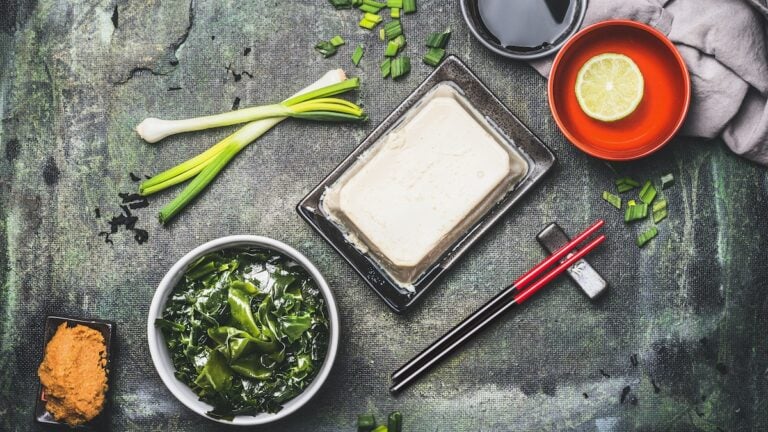
To a beginner, Japanese food can seem complicated to make. I used to think that, too, when I first moved to Japan in 2013.
Now, almost 10 years later, I feel confident cooking Japanese food, and it’s what I make for my family almost every night.
Over time, I discovered that a handful of ingredients show again and again in Japanese food, and if you learn how to use them, you can make tons of your Japanese food favorites.
In this article, I’m going to share the 5 pantry items I recommend you stock in your pantry to start cooking delicious Japanese food at home. I’ll also share a few of my favorite recipes that you can make with them.
Stock up on these 5 pantry items
Here are the 5 pantry items you can use to create tons of Japanese recipes from scratch. I’ll go into detail about each below.
- Mirin
- Soy Sauce
- Sake
- Dashi no moto
- Sugar (you probably have this already!)

Mirin
Mirin is a sweet alcohol that adds a nice well-rounded sweetness to dishes. You can find two types of mirin at the grocery store: hon-mirin (本みりん) is the real stuff, while mirin-fū chōmiryō (みりん風調味料)is an imitation mirin that has less alcohol. I like to buy the real stuff.
Soy Sauce
You’re probably already familiar with this one, and you probably already have a bottle of it at home. There are two main types of soy sauce in Japan: koi-kuchi shōyu (濃口醤油), or “strong soy sauce” is the dark-colored one, while usu-kuchi shōyu (薄口醤油) or “light soy sauce” is the lighter-colored. Interestingly, the light soy sauce is slightly saltier than the dark version. It’s called “light” because of the color, which doesn’t darken lighter-colored dishes.
Sake
Japanese sake, also called nihonshu (日本酒) is an alcohol made from fermented rice. You can buy cooking sake, also called ryōri-shu (料理酒), or just buy the real stuff and use it in your cooking. I like to cook with real Japanese sake because cooking sake is just sake with salt added so you can’t drink it.
Dashi no moto
Dashi no moto だしの素 is the name for powdered dashi broth granules. Dashi is a type of broth made from fish and seaweed that forms the base of many different dishes in Japan, including miso soup. Simply add dashi no moto to water to get a quick dashi broth for cooking.
Sugar
Okay, there’s no need to explain to you what sugar is. But sugar, or satō (砂糖) in Japanese, is favorite ingredient in Japanese cooking. It helps round out the flavors of so many braised dishes, sauces, and stir-frys—you’ll find yourself adding it to everything.
4 Japanese recipes to try
Now that you’ve stocked your pantry, here are some recipes to try:
#1 – Niku Udon
This is a flavorful udon soup with beef or pork added. Serves 2.
- Into a pot, add 2 tablespoons of water, sake, mirin, sugar, and soy sauce, plus 1 teaspoon of dashi no moto.
- Once the sauce is boiling, add 200 grams of thinly-sliced pork or beef to the pot and cook it until the sauce reduces.
- In another pot, make a soup broth with 800 ml of water, 1 ⅓ Tablespoons of soy sauce, 1 ⅓ tablespoons of mirin, 1 tablespoon of dashi no moto, and a pinch of salt and turn on the heat.
- Once the soup starts to boil, add frozen udon noodles and cook them about a minute until ready to eat.
- Top the udon with the meat and chop up a green onion for a garnish.
See the original recipe with photos here [Japanese].
#2 – Meat-Stuffed Peppers
These are a favorite in our house. Serves 4.
- Finely chop ½ an onion and add it to a bowl with 400 grams of ground pork, one egg, 1 tablespoon of potato starch (katakuriko), a pinch of salt and pepper, and 1 tablespoon each of soy sauce, sake, sesame seed oil, and juice squeezed from grated ginger. Knead the mixture until well combined.
- Split 8 green peppers in half, remove the stems and scoop out the seeds. Place them open side up and dust them with potato starch.
- Stuff each pepper with the meat you mixed in step 1.
- Put a pan on low heat, add some oil, and place peppers meat-side down. Add the lid and cook for 5 to 7 minutes until the meat browns. (Don’t flip the peppers over!)
- While cooking, mix up the sauce: 300 ml of water, 3 tablespoons of soy sauce, and 2 tablespoons each of mirin, sugar, and sake.
- When the meat has browned enough, wipe any excess oil from the pan and then pour in the sauce. Leave the lid off the pan and cook until on low to medium heat until the sauce thickens and coats the peppers.
- If the peppers aren’t cooked through yet, you can lower the heat and put the lid on while cooking the sauce.
See the original recipe with photos here [Japanese].
#3 – Bonito Sashimi Bowl
Bonito or skipjack tuna (called katsuo in Japanese) is delicious raw on top of rice with a little bit of seasoning added. Serves 3.
- Fill a Ziplog bag with 2 tablespoons of soy sauce, 1 tablespoon of mirin, 1 teaspoon of grated ginger, and 1 teaspoon of sugar, and mix them well.
- Cut up a sushi-grade cut of katsuo into thick slices (or buy pre-cut) and add them to the bag. Shake the bag a little to coat the fish with the marinade, then seal the bag tightly.
- Leave the fish to marinate in the fridge for several hours or overnight.
- Layer the marinated sashimi on top of steaming hot rice and top with dried seaweed, green onion, roasted sesame seeds, and a raw egg yolk (if you dare).
See the original recipe with photos here [Japanese].
#4 – Yakitori Bowl
This is one of my favorites. Serves 2 to 3.
- Cut one leek (naganegi) into 4-cm-long pieces and sear them in a hot pan. Remove them onto a plate.
- Cut a chicken thigh into bite-sized pieces, add a ½ tablespoon each of soy sauce and sake, and mix well.
- Coat the chicken with flour, then stir-fry them in a pan with a generous amount of oil.
- While they’re frying, mix together the teriyaki sauce: 3 tablespoons each of soy sauce, sugar, and sake.
- When the chicken is cooked well, add the leeks back into the pan and pour in the sauce. Cook on medium heat until the sauce thickens and coats everything well.
See the original recipe with photos here [Japanese].
More recipes
If you want to learn more Japanese recipes, I recommend picking up a good beginner’s cookbook. Over time, you’ll learn what you like to make and it will become comfortable to you, too.
If you can read Japanese, I like the website Cookpad and a cookbook called らくらく和食. If you prefer English, you could check out Harumi Kurihara’s cookbooks (she teaches home cooking on Japanese TV).
Japanese cooking doesn’t have to mystify you! By stocking your pantry with these 5 basic ingredients—mirin, soy sauce, sake, sugar, and dashi no moto—you can make a ton of great dishes! Which recipe do you want to try?
Author: Amanda Horiuchi















